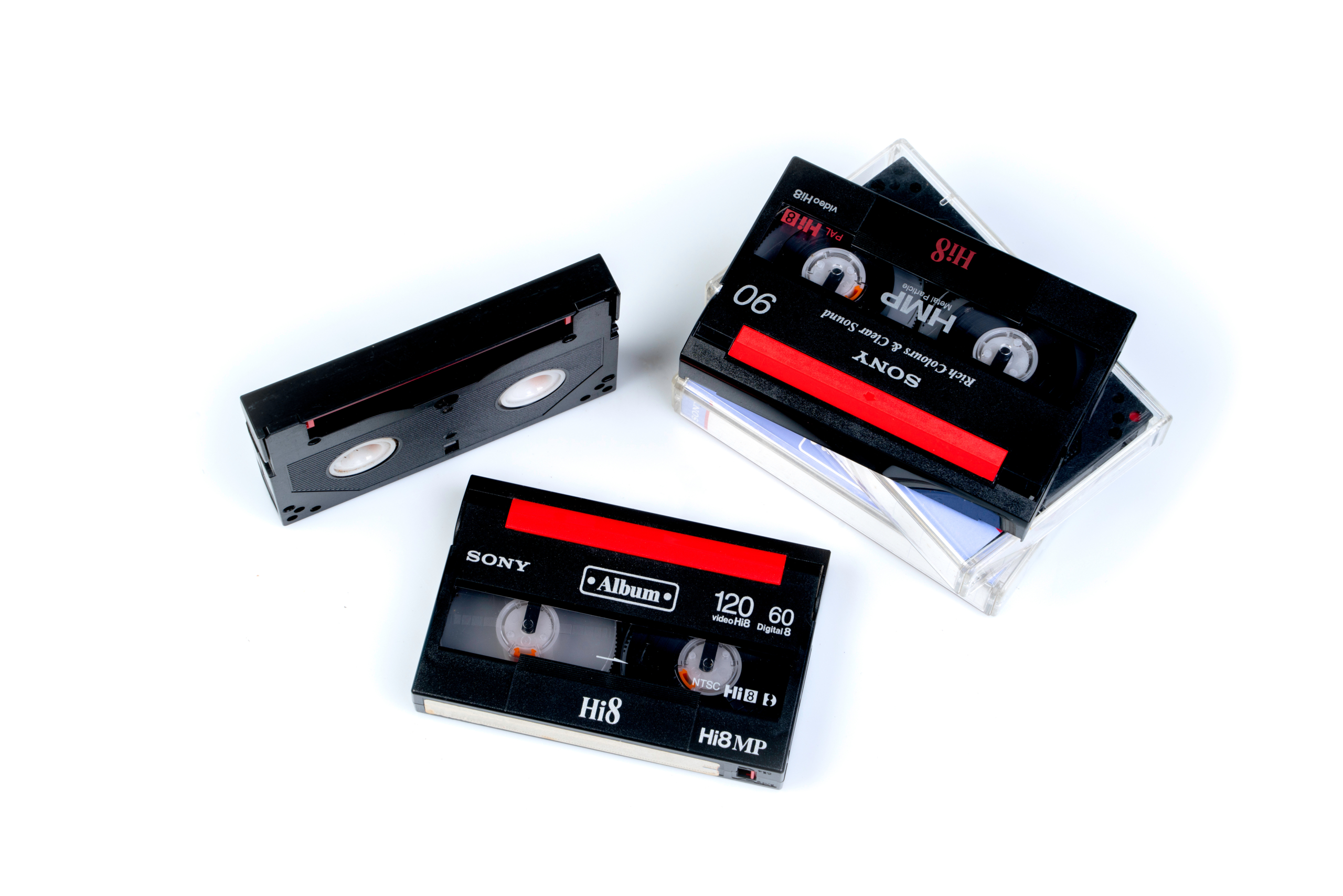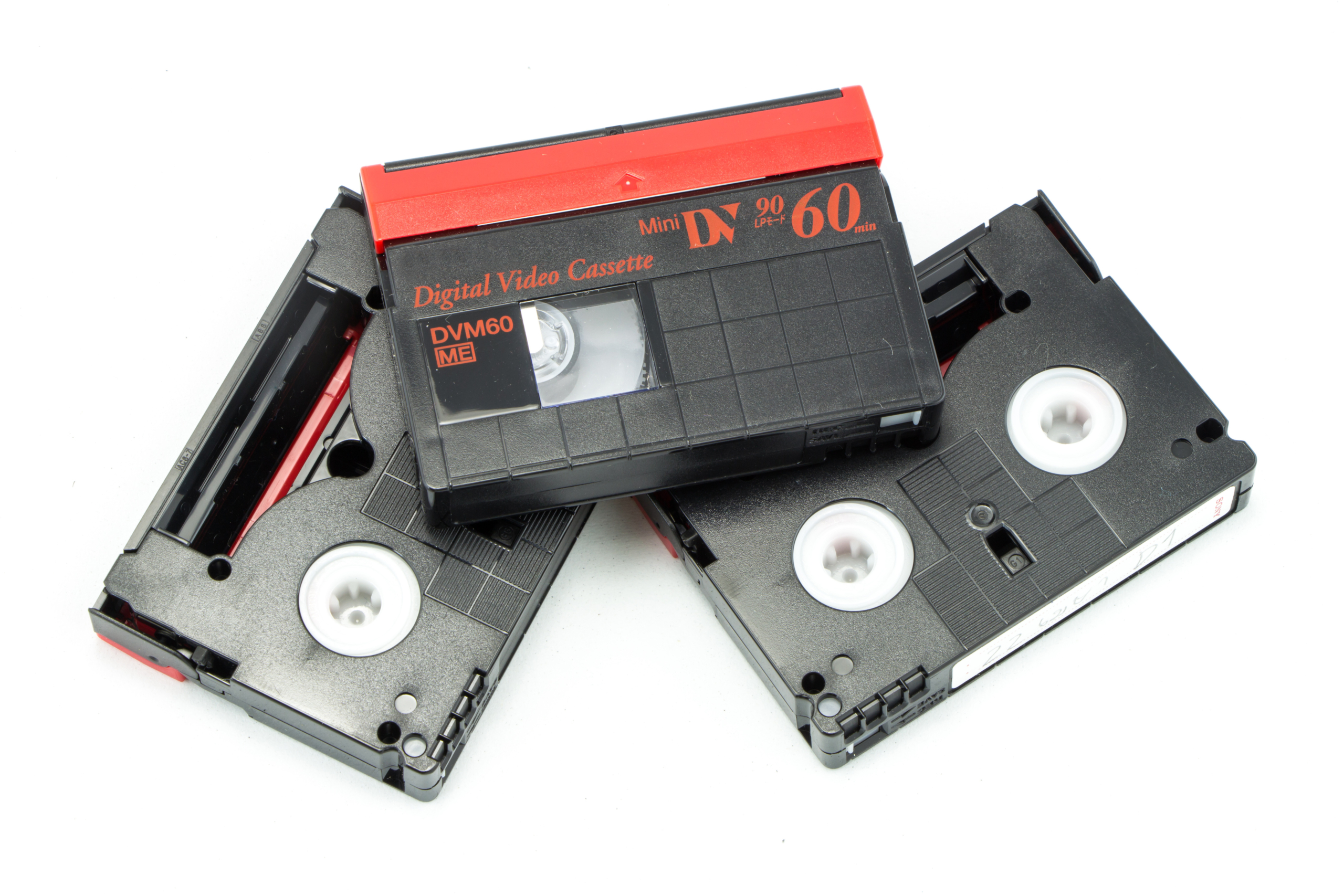There are so many different video cassette tape formats out there that it’s hard to keep track of them all. You might even assume everything sitting in your attic is VHS tapes — but that may be far from the truth!
In this article, we compare two popular formats from the 1990s: Hi8 vs MiniDV. They’re the successors to Betamax and the original VHS tapes. They’re also quite different from what came before them — and from each other.
WHAT IS HI8?

Hi8 is the middle sibling of the three 8mm video cassette formats — Video8 came first, then Hi8, and finally Digital8. All three were very popular with the general public as they were used in lightweight camcorders that allowed families to easily shoot home content.
Hi8 was a direct successor to Video8 and a direct competitor to the Super-VHS format. Its improved recorder electronics upped the luminance resolution to 400 lines compared to the Video8’s 240 lines. Hi8 tapes and their camcorders were also more compact than their predecessors, making them even easier to carry around and film with. Some professionals even used them for shooting news or television content when they needed to prioritize portability.
They were also backward compatible, with all Hi8 equipment allowing users to record and play in Video8 format. Aside from Sony (the inventor of Hi8), brands such as Nikon, Canon, Matsushita, Samsung, and Sharp also offered Hi8 equipment. It was released in 1989 and enjoyed a full decade of undisputed popularity before Digital8 came out in 1999. The transition wasn’t instant, however, and Hi8 camcorders were still bought, used, and even manufactured until 2007.
WHAT IS MINIDV FORMAT?

Digital Video (or DV) was originally developed by the HD Digital VCR Association — a group of electronics companies that included Sony and Panasonic. The standards and specifications the association decided on resulted in a range of formats and products including DV, DVCAM, Digital8, HDV, DVCPro, and MiniDV.
The most popular of these formats was MiniDV because it offered equal quality but in a much smaller size. Released in 1995, the tape was 6mm wide and the cassette itself was 66mm wide, 48mm high, and 12.2mm thick. In other words, seriously small!
As a consumer product, MiniDV cassettes were usually recorded in the standard DV format but they could also be encoded with the higher quality formats DVCAM and HDV, which led to some professional usage too. The small size did mean less recording time, however. Compared to the 270 minutes of the medium DV cassette, the MiniDV could only manage 90 minutes. It’s a lot less in comparison, but at the same time, 90 minutes is plenty of footage for amateur users.
HI8 VS MINIDV: WHAT’S THE DIFFERENCE?
When comparing Hi8 vs MiniDV, it’s important to note that the main difference between these two formats is that the former is analog and the latter is digital. Another big difference is who made them — Hi8 was proprietary Sony technology, meaning only Sony and a few select partners manufactured Hi8 products. MiniDV, on the other hand, was created as a joint project between many different parties and over 60 different manufacturers made MiniDV equipment.
Aside from the fact that it was released six years after Hi8 and had produced higher quality video, this ease of access is a big factor in why MiniDV ultimately became more popular than Hi8 and even its digital successor, Digital8. Also, unlike Hi8 and Digital8, MiniDV tapes are still being manufactured today.
Here are the main features to considering when comparing Hi8 vs MiniDV:
- Better quality tape and increased bandwidth compared to Video8
- Luminance resolution of 400 lines
- Analog video and audio recording, with optional digital audio
- Recording times of 30, 60, and 120 minutes
- PCM audio recording
- Luminance resolution of 500 lines
- Sharper colors
- 640×480 picture resolution
- Recording time of up to 90 minutes in LP mode
HI8 VS MINIDV: WHICH DIGITIZES BETTER?
While both formats can be digitized, MiniDV is easier and produces higher-quality results. The main reason for this is simply that it’s already in a digital format so it’s easier to transfer it into a digital file or onto a DVD.
Digitizing isn’t about ease though, or even about the quality of the results — it’s about preserving content that would otherwise deteriorate over time and eventually be lost. The fact that your Hi8 videos “only” have 400 lines of resolution isn’t a drawback, it’s a feature!
By transferring your Hi8 and MiniDV videos into a digital file, you can save multiple copies in different places and make it very difficult for them to ever get lost. You can keep copies on your phone and post them to social media or send them to friends in seconds. You can also burn a copy onto a DVD for easy playback on your TV or the TVs of older relatives.
DIGITIZE HI8 AND MINIDV TODAY
At EverPresent, we can do all this for you and more. If the size of your Hi8 or MiniDV collection is daunting, we can organize everything and transcribe all of your written labels into digital file names. Or, if your collection is exactly as you want it, we can make sure everything is returned to you in the same order you sent it to us.
You can ship your tapes to us, or we can arrange to pick them up from your home or office — whatever makes you feel comfortable. Our team of over 80 expert technicians has digitized over 50 million memories in the past 30 years, and we know how to keep your collections safe. Contact us here to schedule a consultation and start your digitization project!

